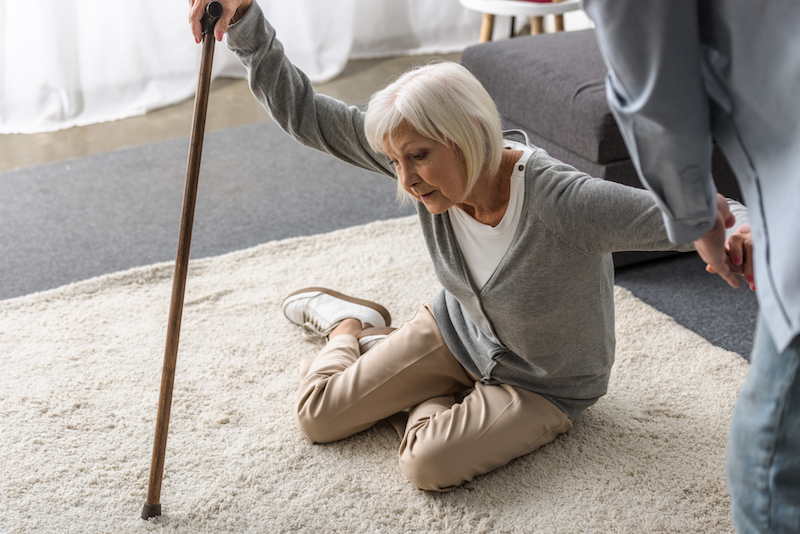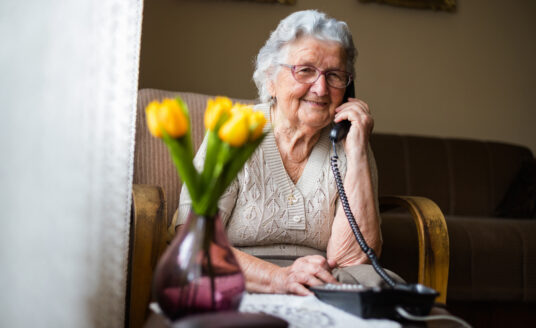As your loved one ages, you may be wondering: “Should I be taking fall precautions at home?” Unfortunately, facts are facts – one in four seniors falls every year. The results of these falls often are broken bones or life-threatening conditions like head injuries.
There are several factors that contribute to this statistic. Many seniors suffer from one or more medical conditions that make a fall more likely, such as muscle weakness, arthritis, medication-induced sleepiness, and balance and gait problems.
Chronic conditions like heart disease, low blood pressure and arrhythmias can lead to fainting. Epilepsy, Parkinson’s disease, dementia and other cognitive disorders can also increase the likelihood of a fall.
When Is It Time to Talk?
There are a number of indications that a senior’s fall risk is increasing. Seniors, caregivers and family members should evaluate these factors to determine what fall precautions should be made around the home to help eliminate falls and increase safety.
- Have you/they fallen in the past year?
- Do you/they use a cane or walker (or been advised to use one)?
- Do you feel/they seem unsteady when you/they walk?
- Do you/they hold onto furniture, railings, or countertops while moving in the home?
- Do you/they have trouble stepping up onto a curb or walking upstairs?
- Is there numbness in your/their feet?
- Do you/they often have to rush to the bathroom?
Reduce Fall Risks with In-Home Fall Precautions
It may be time to look at the home from a different perspective. While you still want it to be attractive and comfortable, you need to identify any area that could present a hazard.
Bathrooms
About 80 percent of falls for seniors occur in the bathroom. This room tends to be crowded with sinks, toilets and tubs, and are covered in tile floors that become slippery when wet.
Place non-slip bath mats beside the tub and in front of the toilet and sink. Support bars in the tub and next to the toilet will also help. In addition, raised toilets can make it easier for seniors to lower themselves to the toilet and stand up after using it.
Shower benches in bathtubs provide a safe and solid place to sit while taking a shower. Walk-in tubs are also an option. Rather than stepping over the side of the tub, these tubs are accessible by a door that swings open.
Bathroom shelves tend to get crowded with gels, lotions, medications and toothpaste. Therefore, it becomes more likely that something will get knocked to the floor, requiring the senior to bend over and retrieve the item. This is not easy for a senior with stiffness and mobility loss.
Kitchen
To avoid using step stools and chairs, most commonly used items should be placed within easy reach. Declutter countertops and refrigerators that may become packed with food to prevent your senior from dropping items and bending over to retrieve them. Small kitchen appliances should be easily reachable. Other safety tips for the kitchen:
- Spills should be cleaned up immediately.
- Anti-slip flooring can decrease fall risk.
- Make sure there is ample lighting.
- Make sure carbon monoxide and smoke detectors have been installed.
Bedroom
There should be a light near the bed that is easy to reach without getting out of the bed in the dark. Seniors should also keep a flashlight near the bed, just in case it is needed. As in every room in the house, make sure clear pathways are maintained. Night lights in the bedroom and in the hallways leading to a bathroom are important. Depending upon your senior’s physical capabilities, a bed rail that fits between the mattress and box spring can provide support when getting out of bed.
Also, and something that many don’t think about, is to make sure that the phone is within arm’s reach of the bed.
Stairs, Hallways, Pathways
Good lighting is imperative in these areas. Family members or caregivers should regularly check to see that all bulbs are working and replace them if they are not. Seniors who are a fall risk should never be standing on a ladder or chair and changing bulbs.
Overhead lighting at the top and bottom of stairs is ideal, with a controlling switch at the top of the stairs. Consider adding a second handrail across from the original stairway rail. Check all handrails to see that they are solidly attached.
Remove all obstacles from stairs, hallways and pathways. Never, even temporarily, set an item on a step.
A general house safety checklist of fall precautions should include:
- Keep electric cords and phone wires clear of walking paths
- make sure the carpeting is secured to the floor
- Put no-slip strips on tile and wooden floors
- Arrange furniture to allow for clear walking space
- Eliminate throw rugs—a major tripping hazard for seniors
- Emergency phone numbers should be kept near all of the phones in the house
In addition, the senior may want to consider wearing a medical alert device, especially if they tend to have balance issues, and purchasing a reach stick for those hard-to-reach items, which should eliminate the need for climbing on step stools and chairs.
Front Steps
The front steps outside the home should be repaired if they are broken or uneven. Some front steps settle and tend to tip forward after a few years. This is particularly dangerous during wet or icy weather. Railings should line the steps, and the lighting around the front door should be checked regularly.
Seniors should not be clearing icy steps, sidewalks, or driveways. If a caregiver, family member or young neighbor is not available, there are professional ice and snow removal services.
| With 133 years of experience, Bethesda has become a leader in senior care, offering independent living, assisted living, memory care, and skilled nursing. To see if independent living is the best choice for your retirement goals, tour any of our locations, including Bethesda Barclay House – Clayton, Bethesda Gardens – Kirkwood, Bethesda Orchard – Webster Groves, Bethesda Terrace – South County, Village North Retirement Community – Florissant, and The Oaks at Bethesda Villas – Kirkwood/Webster. After meeting with our residents and highly trained staff, you will instantly feel at home. |



